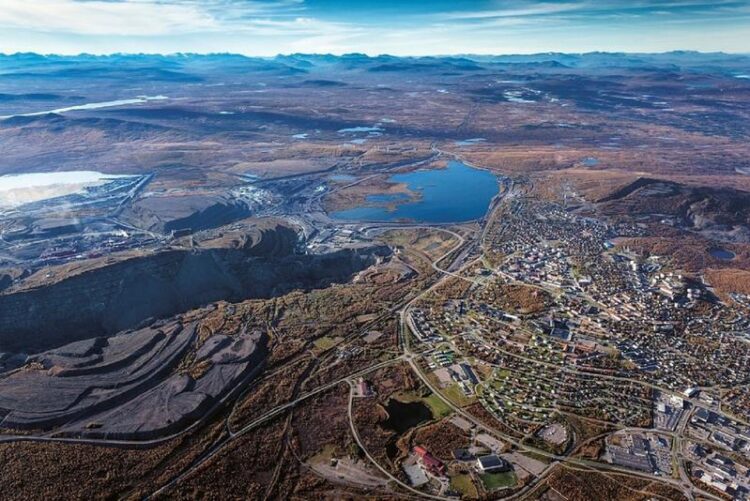Raw material potential for the steel industry

Aerial view of Kiruna with the city and former open-pit mines.
Bild: LKAB
Geology experts of TU Freiberg analyze the quality of Swedish ores.
Research work on the Per Geijer iron ore deposits of Luossavaara-Kiirunavaara Aktiebolag (LKAB) near Kiruna is ongoing at TU Freiberg until August 2021. The results already show a very promising raw material potential for the associated supply of the iron and steel industry.
Iron ore is the basis for the production of iron and steel – the world’s most important materials for the construction of buildings, machines, tools, cars, ships and airplanes. To be able to meet future demand, existing iron ore deposits must be further developed.
One of the largest European mining areas is located in northern Sweden. Researchers from the Division of Economic Geology and Petrology at TU Bergakademie Freiberg have been active in an exploration project for the Per Geijer deposits in the Kiruna mining district since 2018 and support the characterization of the so-called Kiruna deposit type to analyze its raw material potential for iron ore mining.
Deposit research shows great raw material potential
The Per Geijer deposits consist of a total of five ore bodies which, in addition to iron ore minerals such as magnetite (Fe3O4, up to 72 % Fe content) and hematite (Fe2O3, up to 70 % Fe content), also contain significant amounts of phosphate due to apatite (Ca5 [F | (PO4)3], up to 42 % P2O5 content). “Above all, the Per Geijer iron oxide-apatite deposits are of great importance due to the characterization of the in-situ ore and its processability in the future,” explains Patrick Krolop, research scientist at the Division of Economic Geology and Petrology at TU Bergakademie Freiberg.
The mineral-chemical and process-mineralogical data currently compiled in Freiberg indicate positively that the product guidelines can also be complied with in the future and that a high-quality end product will be available. In particular, the low content of penalty elements such as nickel, cobalt and chromium as well as the high degree of liberation of magnetite of over 90 percent after comminution are decisive for this. “With our applied deposit research at TU Bergakademie Freiberg, we are making a significant contribution to the future supply of Europe’s steel industry with high-quality iron ores,” adds Prof. Dr. Thomas Seifert, acting head of the Division of Economic Geology and Petrology.
Practical research for more efficient iron ore processing
The project is being financed by the Swedish company LKAB with a grant of around 430,000 Euros. As Europe’s largest iron ore producer, LKAB has been mining up to 47.5 million tons of extremely high-quality crude iron ore annually in underground and open-pit mining at three locations in northern Sweden (Malmberget, Svappavaara, Kiruna) for 125 years. Kiirunavaara displays LKAB`s most important mine and constitutes the largest underground iron ore mine worldwide. In total, the area around Kiruna comprises four deposits, including the Per Geijer ore bodies.
The final products, the so-called iron ore pellets, are in high demand from steel producers in Europe and around the world. LKAB pellets have a very high iron content of 67 percent and are converted from magnetite to hematite during pelletization. The energy released is retrieved back into the process. This enables a more environmentally friendly manufacturing process. According to LKAB, this should even be completely CO2-free by 2045 and thus complement the exemplary environmental management with innovative iron ore extraction options such as electric and fully automated mining and transport machines.
Wissenschaftliche Ansprechpartner:
M. Sc. Patrick Krolop (Mail: patrick.krolop@mineral.tu-freiberg.de; Phone: +49-3731-39-3516)
Prof. Dr. Thomas Seifert (Mail: thomas.seifert@mineral.tu-freiberg.de; Phone: +49-3731-39-3527/2662)
Originalpublikation:
2019. Minerallogical Imaging for Characterisation of the Per Geijer Apatite Iron Ores in the Kiruna district, Northern Sweden: A comparative Study of Mineral Liberation Analysis and Raman Imaging. Minerals 9 (9), 544; DOI 10.3390/min9090544.
2019. Ore type characterisation of the Per Geijer iron ore deposits in Kiruna, Northern Sweden. Proceedings Iron Ore Conference, Australasian Institute of Mining and Metallurgy, Perth, 343-353.
2021 (under review). Trace element geochemistry of iron oxides from the Per Geijer apatite iron ores in the Kiruna district, northern Sweden: Implications for ore genesis and potential economic products. Ore Geology Reviews.
Media Contact
All latest news from the category: Earth Sciences
Earth Sciences (also referred to as Geosciences), which deals with basic issues surrounding our planet, plays a vital role in the area of energy and raw materials supply.
Earth Sciences comprises subjects such as geology, geography, geological informatics, paleontology, mineralogy, petrography, crystallography, geophysics, geodesy, glaciology, cartography, photogrammetry, meteorology and seismology, early-warning systems, earthquake research and polar research.
Newest articles

Superradiant atoms could push the boundaries of how precisely time can be measured
Superradiant atoms can help us measure time more precisely than ever. In a new study, researchers from the University of Copenhagen present a new method for measuring the time interval,…

Ion thermoelectric conversion devices for near room temperature
The electrode sheet of the thermoelectric device consists of ionic hydrogel, which is sandwiched between the electrodes to form, and the Prussian blue on the electrode undergoes a redox reaction…

Zap Energy achieves 37-million-degree temperatures in a compact device
New publication reports record electron temperatures for a small-scale, sheared-flow-stabilized Z-pinch fusion device. In the nine decades since humans first produced fusion reactions, only a few fusion technologies have demonstrated…





















